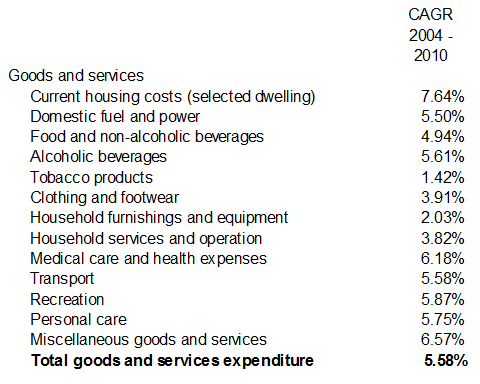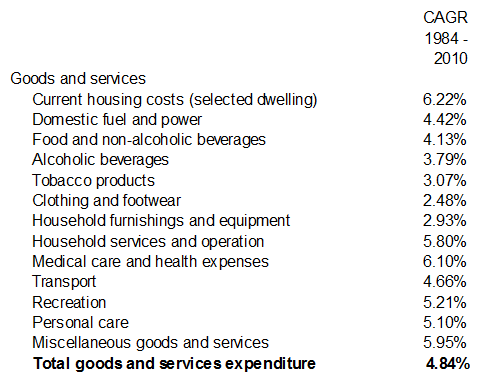So how much money do you need in retirement? Two weeks ago, in part 1 of this series, I put forward eight variables that directly affect the timing of retirement. If you haven’t already, I’d suggest that you revisit the blog from two weeks ago (click here) and consider how each variable impacts your ideal retirement timeline. This week I’d like to focus on what returns need to be made to achieve the required amount of capital to see you through your retirement.
While you may be starting to understand your retirement situation a little clearer, it’s critical that you now work towards the next phase and understand how much money you’ll need to live out the life you desire. It’s not important to comprehend how you’ll get there just yet; rather I’m going to help you recognise the variables that affect capital growth and retirement. When it comes to growing capital, there are 6 factors that influence returns:
- Your capital base, or how much money you have to start with.
- How much capital you plan to add to the capital base over time.
- The length of time you have to invest.
- The rate of return.
- The effect of compounded return.
- Inflation.
Each of these factors will have a direct effect on how much money you’re left with when the time comes to retire. Let’s look at each of these factors independently.
Before you read any further, write down right now what you think the average rate of inflation has been in Australia over the last 26 years. Ok, read on.
The capital base
The more money you have, the easier it is to invest. Quite simply, a large capital base will allow you to take less risk and compound a larger amount. For people with a small capital base, you may have to search for a greater return which inevitably comes with greater risk.
How much capital you continue to invest
This adds up. The more money you can consistently put aside for retirement, the more likelihood you’ll have more money when the time comes. Money consistently added to money creates compounding.
The period
Whether you have 10, 20 or 30 years until you retire; the period of time you have to invest will make a dramatic difference to the size of your capital base when it comes time to retire. The earlier you start on the journey, the bigger the pie at the end.
Rate of return
The rate of return or acceleration rate at which your money grows has a huge effect on growing capital. Just a few percentage points here and there each year can make 100’s of 1000’s of dollars difference over one’s investing lifetime.
Compounded return
Albert Einstein was once quoted as saying “the most powerful force in the universe is compound interest”. Compounding is so powerful in fact that in some counties and religions it is actually illegal to compound money (for another time). I’ve spoken about the subject of compounding money in the past and I believe it’s the ‘Holy Grail’ or crux of active investment.
Inflation
Your money is losing value by the day. As inflation takes affect and goods and services become more expensive, your money becomes less valuable. While milk and bread may remain roughly consistent with CPI, the chances are that when it comes time to retire, that you’ll be spending money on travel and other luxury goods that may rise faster in price than the CPI rate. This needs be taken into consideration pre retirement.
Calculating your inflation rate
More importantly, you should try to calculate your own inflation rate and not just accept the general and averaged ABS CPI figure as being applicable to your situation as an indication of inflation. Depending on your lifestyle, your age group, where you live and the types and size of products and services that comprise your expenditure there is a high probability that you have a different inflation rate to the official CPI. In fact, you may come to the conclusion that CPI is meaningless as a measure of inflation for you when you read the following facts that you simply will not find any politician referring to!
Consider the following calculations which are sourced from the Australian Bureau of Statistics (ABS). From 2004 to 2010 the absolute increase in CPI was 19%, or 2.94% compounded p.a. CPI measures changes in prices, not what households are spending.
However, the average household expenditure increased by twice as much at 38%, or 5.58% compounded p.a. over the same period across all goods and services, all households (there are many categories), all age groups (of which there are 6 sub categories) and all states (capital cities and country side). However the biggest household expenditure increases were in housing costs (6 sub categories) which, according to the survey, comprises 16.1% of household expenditure (yours may be higher, or lower) at 7.64% p.a. with the sub categories of ‘mortgage payments’ rising at 9.78% p.a. and ‘rent’ at 9.03%. These are more than 3x higher than CPI!
So should you use CPI or your household expenditure as your proxy for your inflation rate? In my view the household expenditure is closer to the mark. There are also other sources that can be researched on the ABS website such as the Analytical Living Cost Index.
The other major categories are listed below. If you think that this may just be a recent phenomenon then think again. Here are the annual compounded rates of increase in household expenditure from 1984 – 2010 which, while lower, are still relatively high.
If you think that this may just be a recent phenomenon then think again. Here are the annual compounded rates of increase in household expenditure from 1984 – 2010 which, while lower, are still relatively high.
 In comparison CPI has compounded at 3.72% p.a. from 1984 – 2010.
In comparison CPI has compounded at 3.72% p.a. from 1984 – 2010.
I’m sure that most would have written down an inflation figure closer to 2.5% or nearly half the rate at which household expenditure has been rising over the 26 years to 2010. So what’s the difference between 2.5% inflation and 4.84% over 28 years? Well a dollar in 1984 is worth 50.6 cents today with inflation at 2.5% but at 4.84% it is worth 26.6 cents!
It should also be considered that the policies being used by central banks in Europe and the USA to ‘print money’ will most likely lead to higher rates of inflation in the future.
The other part of the equation is how incomes have grown in relation to expenditure but that is more relevant to calculating your current situation than your future retirement position.
How does knowing this affect our view of how we should go about planning for our futures and our retirement?
Retirement tables
I’ve prepared three performance tables so you can identify a likely outcome at the point of retirement. Here are some explanations about the tables. Table 1 has low compunded returns (0% – 5%), Table 2 medium (6% – 12%) and Table 3 high (15% – 30%) returns, more for comparison than being realistically achievable. Whilst even higher returns could be considered it is an extremely low probability that they could be sustained over 20 years.
It’s impossible to take every investor’s capital base and investment period into consideration so to give an idea to readers I decided on a sample investment period of 20 years, taking into account starting amounts of <$200,000 and a compounded annual inflation rate of 4%. I have used two separate columns for each percentage return so you’re able to understand the difference between the actual performance (Tomorrow’s $) versus what the return will equate to if your inflation rate averages 4% for the next 20 years (Today’s $).
Also included for each starting amount is an option to add $100 per month, unindexed for inflation.
Table 1
 Table 2
Table 2
 Table 3
Table 3

Click here to download the Compound Growth Tables spreadsheet should you wish to edit the parameters to your unique situation.
Once you have an idea of how much money you’ll need in retirement you have taken a big first step in your retirement planning, the next being how to solve the challenge of achieving your desired returns. We’ll make an attempt at tackling this next week.
Every one of us has a different idea of what life in retirement may look like. Some will plan to fulfil their life long dreams, while others are comfortable spending time with family and friends. Whatever life you plan to lead in retirement it needs to be a choice rather than it being forced upon you. This requires that you financially plan ahead. There is no truer statement than “The financial actions you take or don’t take today will directly affect your future”. This is not a throw-away line. The decisions you make today require an action!
Next week I’ll discuss Growth Vs Protection.



2 Responses
Have you factored in tax into these calculations?
If not, investors will need alot more money given the contributions and earnings taxes.
Gary has simplified the issue of life expectancy in quoting the UN figures for Australia of 78.9 years for men and 83.6 yers for women: those are life expectancies at birth. In reality, as one gets older, one’s life expectancy increases.
For instance, I’m now 67-68 and my life expectancy is now 87 (in 2031)and my wife, who is 63 has an expectancy of 94-95 (in 2044). That means a lot more years of retirement to fund.
It gets worse: the above expectations are 50% chance. There is a 25% chance my wife will live to 100, in 2049, and a 10% chance she’ll be alive in 2053.
For your interest, here is a link to an actuarial survivorship calculator:
http://www.netactuary.com.au/Calculators/SurvivorshipCalc.aspx?ID=smsfreview